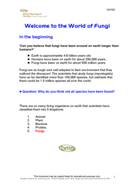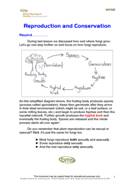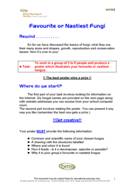|

The learning resources described here are in the form of five class sheets that
together provide a complete mini-course about fungi. The material could be
delivered in a series of five lessons – minimising the amount of time needed to
compensate for the deficiencies of the National Curriculum – but they can also
be used separately, and as the basis for wider and more extensive classroom activities. Although
designed to complement the microbiology content of the AQA GCSE Applied Science
(Double Award) Specification (AQA, 2006) the class sheets can be used in a wide
variety of ways for other specifications as the resources provide topics for
pupil investigations, class debates and discussions, and self-directed
activities.
The Teacher's Guide includes some background information BUT ALSO includes
advice about delivery and answers to the questions that are posed to the pupils
on some of the sheets [CLICK
HERE to download the Teacher's Guide].
We also offer a collection of six
question sheets for your students. These incorporate clozes,
'label the diagram' exercises and free form short answer
questions. They are keyed to the World of Fungi worksheets
listed below.
CLICK
HERE to download a PDF compendium of these 'Quick
Questions'. There's a corresponding set of solutions, too:
CLICK
HERE for the compendium of solutions.
Remember, also, that you can usefully combine these class
sheets with those in the other packages; some of the possibilities are noted
after the brief descriptions below.
|
World of Fungi Class sheets |
WF01
 |
Welcome to the World of
Fungi introduces Kingdom Fungi to the pupil. A brief overview
describes how long fungi have existed and how many species may exist, this
indicates the sheer size and persistence in time of Kingdom Fungi. The
rest of the package focuses on the structure, growth mechanism, feeding
methods and introduces the numerous places fungi are found. Includes a
‘matching’ task for the pupils. Note also WF01 concludes with 3 pages of
Teacher Guidance that is not intended for distribution to pupils.
Provided in two formats: PDF file (for easy printing) and as a Word.doc
for you to edit and modify as you wish. NOTE also the FF16: What
are Fungi? PowerPoint Presentation - 14 slides giving a general overview
of fungi, and offered as a
PowerPoint PPT file and as a set of
PDF
sheets that you can copy onto OHP transparencies.
Download the PDF file
Download the Word.doc
|
WF02
 |
Reproduction and Conservation briefly reviews what was covered in the
previous lesson to remind the pupil. The reproductive cycle is described
in detail. Both sexual and asexual reproduction are revised using short
statements, and reproductive cycles are provided for pupils to exercise
their visual memory. Methods of spore dispersal are described using
colourful pictures of particular fungal species as examples to allow the
pupil to visualise dispersal methods. Provided in two formats: PDF file
and as a Word.doc.
Download the PDF file
Download the Word.doc
|
WF03
 |
My
Favourite or Nastiest Fungus was designed for a two-hour lesson. The
first session required the pupils to work in groups of 2 to 4 and
research a particular fungus in the school’s IT department on the
Internet. Some website addresses are provided. Each team has to meet
stated criteria to produce a poster in the second session explaining why
the fungus was their ‘favourite’ or ‘nastiest’. Offering the best poster a
prize and/or award certificate will give the pupils an incentive to work
hard and made the research process a fun and enjoyable activity. This
package incorporated teamwork, IT, enquiry, information processing and
creative thinking skills. Provided in two formats: PDF file and Word.doc.
Download the PDF file
Download the Word.doc
|
WF04
 |
Fungi and Industry summarises some production methods that depend on
fungi, and can use the British Mycological Society’s ‘Supermarket
Challenge’ and 'Thank
Fungus for That' posters to make the topic relevant to the pupils by
showing the wide range of every-day products that depend on fungi
[Warning: these posters are large files, be patient with the download]. An
introduction to the types of fungi that benefit human health is also
given. The resource provides many opportunities for classroom debates over
topics as diverse as transplant ethics, nutrition and the ‘need’ for food
supplements, and the effects of long-term treatment for chronic ailments.
This package incorporates communication, application of number and
thinking skills. Provided in two formats: PDF file and
Word.doc.
Download the PDF file
Download the Word.doc
|
WF05
 |
Fungi and Disease can be usefully started with a brief verbal summary
to revise the nature of microorganisms and pathogens. A description of
plant and human fungal pathogens is provided in the class sheet, and the
pupils are given brief descriptions next to pictures of several human and
plant fungal diseases (you could remove these to leave blank space in
which pupils are required to write notes). A brief case study describing
the effects of the pathogen Phytophthora infestans in the Irish
Potato Famine is provided that could be the basis for a class project
combining biology, history, geography and community studies. Provided in
two formats: PDF file and Word.doc.
Download the PDF file
Download the Word.doc
|
|
CLICK HERE to
download a single PDF file containing all of the above. |
|
Remember: class sheets may
be copied freely for education purposes. |
The resources included in the package entitled
What’s Your Favourite Fungus?
could be incorporated to enhance these lessons. The collection of fungus
‘stories’ includes a wide variety of information, which could contribute in many
different ways to the above. For example, stories about chytrids, mycorrhizas,
timber decay and the largest organism could contribute to WF02; those about
bread, cheese, Quorn, citric acid and Marmite to WF04; and stories about statins
and cyclosporin, as well as rice blast and powdery mildew to WF05. Any of the
FF-stories could be the basis of alternative topics for the Internet research
and poster making in WF03, and there are also resources on the
Additional Resources page that could be
the starting points for pupil-driven research.
Close the window to
return to the home page |